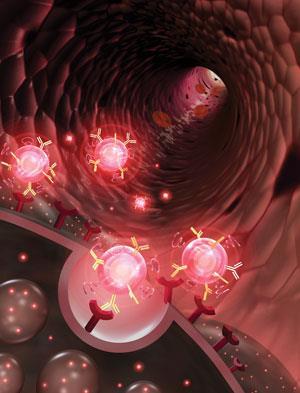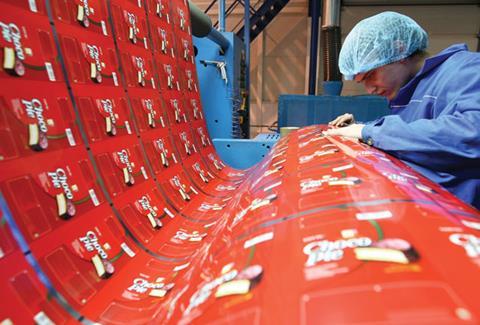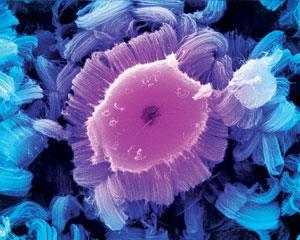There is a risk that poor toxicology studies could start undermining the success of nanomaterials, reports Elinor Hughes

Nanomaterials have been on the scene for over 15 years and they are being applied in a variety of sectors including coatings, textiles, energy, security, IT, food, cosmetics and medicine. Nanoparticles – particles in the 1–100nm range – have unique properties compared to their larger counterparts such as the ability to squeeze into spaces inaccessible to larger particles. But with the research still in its infancy, their long-term effects on human health and the environment remain poorly understood. Concerns have also been raised about the way nanomaterial toxicity data is reported.
The end of the 1990s saw considerable investment in new nanoscale materials thanks to their distinct properties. But, by creating these tiny particles, scientists were creating potential new ways for materials to interact with the human body and the environment. ‘That was one of the big drivers behind concern over nanoparticles. Then there is the secondary possibility that without knowing what these new risks are and how to manage them, people may pull back from trusting or investing in the technology,’ says Andrew Maynard, director of the University of Michigan Risk Science Center in the US. ‘One of the clearest places to see this is in the food industry, which as a whole has pulled away from using nanomaterials because there seems to be too much uncertainty around the products.’
It has been suggested that if care isn’t taken over the way nanomaterials and data on nanomaterials were handled, they could develop a reputation similar to that of genetically modified (GM) crops. ‘That concern was grounded in early research,’ says Maynard. ‘There was emerging evidence that there were unknown mechanisms with which small particles interfered with biological systems. Then there was a fear within business and policy communities that people would begin to associate the term “nano” with potential risk like we saw with GM crops.’

Every now and then, nano-related health-scare stories crop up. In 2009, the University of Ulster in Northern Ireland issued a press release detailing an investigation into a link between manmade nanoparticles and Alzheimer’s and Parkinson’s disease. Vyvyan Howard, a pathologist and toxicologist, and Christian Holscher, an expert in Alzheimer’s disease, were investigating whether human engineered nanoparticles, including titanium dioxide – the active ingredient in sunscreen – can induce neurodegenerative disease. They observed that the nanoparticles can have an impact on the protein misfolding associated with the diseases. Maynard’s response at the time was that there was nothing wrong with the work, but that the risk was probably low as previous research had shown that the nanoparticles can’t penetrate the skin and that there were even indications that the nanoparticles form a strong protective barrier on the skin. Nevertheless, the link had made newspaper headlines.
Testing concerns
Care over the way tests are carried out and the way that the data is reported is one of Harald Krug’s largest concerns, explains the former head of the lab for materials–biology interactions at the Swiss Federal Laboratories for Materials Science and Technology. Krug recently published a review in Angewandte Chemie called Nanoparticle research – are we on the right track? In this he states that toxicology tests carried out on nanoparticles by researchers with no toxicology expertise are not fit for purpose. He scoured 6600 medical, pharmaceutical, toxicological and biological papers for tests done on nanoparticle uptake via the skin, the gastrointestinal tract and the lungs and found that most have serious errors. One of the problems is that researchers aren’t carrying out true toxicity tests, he says. What they are doing is testing how a nanomaterial that gets into the body causes a biological effect, which is important in terms of human health implications, but a true toxicity test identifies the lethal dose, an intermediate dose and the dose with no effect.
Krug revealed that there are examples of exposure studies in animals in which researchers have used grams of nanoparticles, which in many cases represents an overdose way above normal exposure levels. One such study showed that cells treated with even a minor overdose of a nanomaterial in an in vitro test died because they were covered by agglomerated nanoparticles, which had cut off their nutrient and oxygen supplies. Results like this could give a false impression of the toxicity of the nanoparticle in question, as the true dose that the human body would be exposed to is not used. As Krug points out, if a human overdosed on common table salt, it would be fatal.

One reason that errors like this are being made is that a large number of groups carry out their toxicology studies without any knowledge about toxicology rules, explains Krug. This is a situation that he has tried to rectify. In 2011, as part of a European Commission funded project called Nanommune, Krug edited a handbook of standard procedures for nanoparticles testing that described ways to prepare nanomaterials for assays, how to prepare suspensions, how to do the toxicity assays and how to validate the toxicity assays. ‘It’s freely available on the web but nobody respects it,’ laments Krug. ‘New projects funded by the European Commission do not state that researchers have to use these handbooks. So the same mistakes that were made 10 years ago are being repeated again and again.’
In industry, the aim is to develop safe and commercially viable products, so there are strict guidelines for toxicity tests such as those established by organisations such as the Organisation for Economic Co-operation and Development. Companies need to be sure that the toxicity or safety of a product complies with regulations, as well as with internal policies and values, to maintain brand trust, explains Maynard.
Research labs on the other hand aren’t conducting studies for regulatory compliance, and do not have the same impetus to follow good laboratory practice and other established methods. The plus side of this is that academics have the flexibility to develop novel practices that may be more appropriate. ‘The bottom line is that in industry, there are levels of traceability in how the toxicity of substances are evaluated that isn’t required in academic research labs,’ Maynard says. ’Of course, where we are still learning how best to evaluate toxicity – as is the case with engineered nanomaterials – established best practices may not actually be the most appropriate practices.’
Leave it to the experts
‘What Krug needs is a lot of proponents on both sides of the ocean pushing this,’ says US toxicologist Timothy Nurkiewicz, who tests nanomaterials in inhalation experiments by simulating occupational, environmental or personal exposure atmospheres at West Virginia University’s school of medicine.
US government investment into the impact of nanomaterials is above $100 million per year
According to Nurkiewicz, the problem is that not all nanomaterial studies are being published in toxicology journals, so reviewers aren’t necessarily looking at the toxicological data in the same way that a toxicological expert would. Nurkiewicz says that the first things he looks at when reviewing a paper are the toxicological tests and safety data. ‘If a paper comes in without proper characterisation of the nanomaterial or the doses used aren’t relevant, it can get a rapid rejection,’ he says. This leads to a trickle-down effect in which the paper is submitted to another journal that isn’t as sensitive to the issue, he adds.
Making sure everyone is on the same page in terms of sharing knowledge and getting the right equipment for tests takes money and this has been an problem. In 2006, Maynard was part of a group pushing for increased government funding for nanomaterial safety tests. He says that there has been a significant jump in funding levels since then. ‘Now, US federal government investment into the environmental and health impact of nanomaterials is somewhere above $100 million [£67 million] per year,’ he says, adding that there is a similar level of investment in Europe. The recipients of this funding vary. US research funding from agencies such as the National Institutes of Health typically goes to toxicology researchers who collaborate with groups synthesising materials.
Research funding in the US is available from federal agencies and professional associations to enable researchers to develop specific toxicological methods and techniques. Currently, competitive funds are available from societies such as the Society of Toxicology for synthetic chemists to better assess the toxicity of the nanoparticles they have created. ‘There are programmes for travel and sabbatical activities in which investigators can go all over the world to learn about toxicology,’ says Nurkiewicz. ‘If we could increase investment in that, it could certainly help.’ He also supports teaming up researchers that have a lack of expertise in toxicological assessments with card-carrying toxicologists.
Public perception
So investment is being made to ensure that testing methods could be standardised, but with nanotechnology research gathering pace as even more applications emerge, safeguarding their reputation for the future is paramount. ‘The responsibility falls on scientists to educate the public lest we repeat GM crops,’ says Nurkiewicz. So far, the fear hasn’t materialised and one of the reasons could be that ‘the GM story was about one or two large companies trying to force their technology onto communities and people not liking that approach’, says Maynard. ‘You don’t see that with nanotechnology.’ In fact, consumer surveys on the perception of nanotechnology have indicated that only around 30% of participants are aware of any issues. ‘They’re interested in what nanotechnology can do and they’re slightly worried about it going wrong or having an adverse impact, but they’re not that concerned.’ But any worries about nanoparticles, no matter how slight, can affect product sales and this could explain why the food industry has pulled away from using them.

This largely positive public attitude towards nanomaterials has however meant they are now able to be investigated for use in medical applications unhindered, but this could lead to more stories appearing in the press. There are promising techniques for using them as carriers for drug delivery, in particular for treating cancer. They can also be used as scaffolds inside the body to build up new bone or tissue. There are even soft nanomaterials made out of lipid- and silica-based materials that can dissolve over time to mimic biological materials for use in the body. Nanomaterials can also affect the environment in a positive way. Another application is the use of quantum dots in TV screens in which they increase the screens’ energy efficiency, so decreasing the energy used.
Unfortunately, somewhere along the way, some researchers have become preoccupied with proving that certain nanoparticles have a damaging effect. ‘They become fixated on things that probably aren’t important and ignore the things that could be important. That can be very damaging,’ says Maynard. For example, hundreds of millions of dollars have been spent on trying to understand the toxicity of nanometre-sized silver particles, which by all accounts are pretty benign in humans. Yet, there has been virtually no research on catalyst particles in vehicle exhausts, very potent nanoparticles that are released into the environment. ‘Funding agencies take their lead from what the research community thinks is important, as well as broader strategic directions and issues that are emerging,’ explains Maynard. ‘The catalyst particles would only be studied if a lot of people thought that there was a safety issue. The issue here is: why are these questions being asked about some nanoparticles, but not others?’
Nurkiewicz is concerned about the way that nanomaterials are being promoted too negatively and would like to see more scientists educating others about their research and considering how their nanomaterials will be applied in the future. ‘Every scientist worth their salt is dedicated to education and teaching. If we can’t do that, then we’re not doing our job,’ he says.
Scientists do face a battle, with the word ‘nano’ being misused, which can cause problems if things go wrong. In 2006, Magic Nano, a German cleaning product, was taken off the shelves because it was claimed that its nanoparticles had caused respiratory problems in 80 people. It was later found that the product contained no nanoparticles, and the blame was placed on the propellant, but the damage was done. ‘Of course, there are nanomaterials that have bad reputations, but the problem is confounded by companies that see the word “nano” as sexy,’ says Nurkiewicz. ‘If you put nano on your product’s name, it’ll sell more, right? And that makes it a little harder too.’
Elinor Hughes is a science writer based in Bridgend, UK












No comments yet